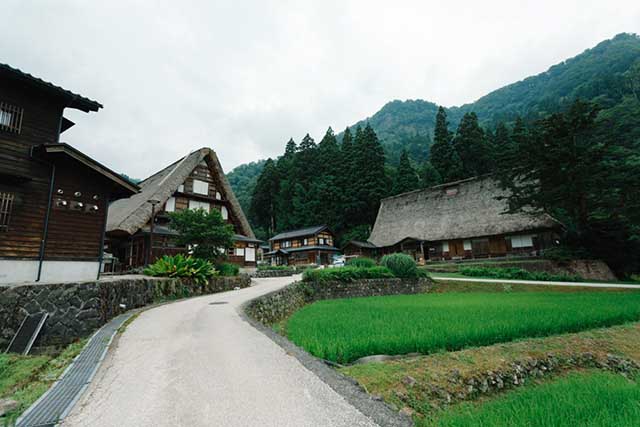
If the stunning scenery of the Gokayama region wasn’t already a good enough reason to visit, the centuries-old gassho-style houses of Ainokura Village are sure to have you convinced. Wander between the farmhouses’ impressive thatched roofs before stepping inside for a true slice of old mountain life.
-
The Gokayama region is home to two gassho-style villages: Ainokura and Suganuma, with the former the largest and most activity-packed of the two. Gaining the status of UNESCO World Heritage Sites in 1995, the villages’ heavy contribution of the explosive niter during the Edo Period, from the 17th to 19th century, helped them to prosper in the Kaga Domain which is to thank for the careful preservation of these unusual farmhouses to this day.
![Visit the Thatched-roof Houses of Ainokura Village]()
Visit the Thatched-roof Houses of Ainokura Village
- Thatched-Roof Houses of Ainokura Village
-
4.5
58 Reviews -
-
- Toyama Pref. Nantoshi Ainokura
-
-
-
- 0763662123
-
-
-
- 8:00-17:00
-
View AllGOKAYAMA BASE
下梨2407 Takaoka

The gassho-style houses of the region are unique constructions made using no nails with the heavily slanted thatched roofs designed for the winter months when the villages are covered in a blanket of snow.
![Visit the Thatched-roof Houses of Ainokura Village]()
Visit the Thatched-roof Houses of Ainokura Village
While there are still around 60 residents living in Ainokura Village today, a number of the houses have been done up so visitors can pop in and have a look around. The Ainokura Folklore Museum and Traditional Industry Museum are open to the public for a look around the inside of one of the Gassho-style houses while getting a more in-depth look into the important heritage of folk music and dance in the village as well as the traditional dress.
![Visit the Thatched-roof Houses of Ainokura Village]()
Visit the Thatched-roof Houses of Ainokura Village
- Ainokura Folklore Museum
-
4.0
32 Reviews -
-
- Toyama Pref. Nantoshi Ainokura 352
-
-
-
- 0763662732
-
-
-
- 8:30-17:00
-
View AllGOKAYAMA BASE
下梨2407 Takaoka

Near the entrance of the village is a building offering washi paper making. Not run as formally as an organized workshop, anyone can try their hand at creating this traditional paper with the help of the relaxed shop owner to demonstrate how it’s done. After patting the paper into the right shape and adding your own design, the water is suctioned out of the paper mixture for a colorful final result.
![Visit the Thatched-roof Houses of Ainokura Village]()
Visit the Thatched-roof Houses of Ainokura Village
The village is home to both Shinto shrines and small temples with Jinushi Shrine at the center of the village one of the largest and most important. Constructed to enshrine the village’s guardian deity, the shrine is on a higher platform than the rest of the village up the stairs protected by a torii gate. Before the shrine is the Twenty Days Stone which helps locals to judge how quickly the winter’s snow will clear and to the left is Sonen-ji Temple, a Jodo Shinshu Buddhist temple which is regarded as the religious center of the village.
![Visit the Thatched-roof Houses of Ainokura Village]()
Visit the Thatched-roof Houses of Ainokura Village
Myths and old stories from the old villages are endless with rumors of the Ear Valley acquiring its name from a snake that had ears and the Footprint of Tengu where a tengu (heavenly dog) passed by the village in the past. The area offers several short hikes around the beautiful woodland to make the traditional world come back to life.
![Visit the Thatched-roof Houses of Ainokura Village]()
Visit the Thatched-roof Houses of Ainokura Village
Despite it’s difficult location Gokayama is well sign-posted for those coming by car, which is one of the easiest ways to access Ainokura Village. Alternatively, take the bus which will take you directly from Takaoka Station in the north of Toyama to Gokayama in just over one hour. Arriving at lunchtime? Ainokura Village offers two cafes as well as a souvenir shop and a number of restaurants in the surrounding hamlets.


 Go here
Go here
















